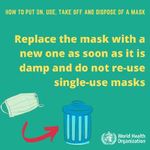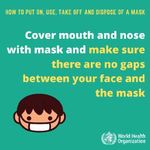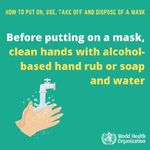CORONAVIRUS: Advice for chiropractors March 26, 2020 - World Federation of Chiropractic
←
→
Page content transcription
If your browser does not render page correctly, please read the page content below
CORONAVIRUS:
Advice for chiropractors
March 26, 2020
On March 11, 2020, COVID-19 was declared a pandemic by the World Health
Organization (WHO). As at March 26, 2020, there have been over 416,000
confirmed cases in 197 countries, areas or territories. There are currently over
18,500 confirmed deaths. Chiropractors are primary contact health care
professionals and to protect themselves, their patients and their communities they
must stay current with the latest scientific evidence, information and advice. In
many countries around the world chiropractors have ceased providing direct,
hands-on care to patients in response to governmental or health policy advice.
The global situation regarding COVID-19 is evolving daily and advice may change
over time pending developments and emerging scientific knowledge. This advice
note is current as of March 26, 2020 and has been produced with advice and
guidance from the WFC Research Committee and WFC Public Health Committee.
Key messages
1. The WFC acknowledges the service of chiropractors around the world in contributing to the health of
nations. We recognize that this is a challenging time and that we are in unprecedented territory with regard
to the global outbreak and spread of COVID-19. As a worldwide community, the WFC understands that
there are many questions being asked of chiropractors and that the situation varies from country to country.
In order to support the global efforts of our fellow health professionals it is of critical importance that
chiropractors communicate information to their patients and communities that is scientifically accurate and
comes from authoritative sources.
2. Advice communicated to patients by chiropractors and their staff should be based on advice from WHO
and official national public health agencies in their country.
3. There is no credible scientific evidence that chiropractic spinal adjustment/manipulation confers or boosts
immunity. Chiropractors should refrain from any communication that suggests spinal
adjustment/manipulation may protect patients from contracting COVID-19 or will enhance their recovery.
Doing otherwise is potentially dangerous to public health.
4. Chiropractors must comply fully with all government directives in relation to the COVID-19 pandemic,
which may include ceasing the provision of direct-contact patient care.
5. COVID-19 may be transmitted from person to person and may be contracted from surfaces on which the
virus is deposited. Where they are continuing to provide essential services to patients, it is of critical
importance that chiropractors, their staff and all visitors to their facilities are scrupulous about personal and
clinic hygiene, including the practice of hand washing, respiratory etiquette, physical distancing, sanitization
of all equipment and surfaces and appropriate use of personal and protective equipment.
16. Current evidence is that the elderly and those with co-morbid health conditions are particularly at risk.
Care must be taken to minimize potential spread of COVID-19 to these special populations. Multiple nations
and regions of the world are now subject to special measures including enforced physical distancing.
7. While most fatalities have occurred in the elderly population, it is now known that young people, including
children, have died from COVID-19. Those not exhibiting symptoms can still carry and transmit the virus.
8. Chiropractors and their staff should ensure they are familiar with information about COVID-19, which is
set out below. They should monitor the WHO website, government directives, advice and guidance from
regulators and official sources of public health advice in their respective nations, states and provinces.
9. WHO recommends that those with mild signs and symptoms of COVID-19 disease are isolated and
cared for at home. It is important that care-givers take all necessary precautions to protect themselves. This
means that the patient and the care-giver should wear medical masks. Patients should sleep in a separate
room and use a separate bathroom. One care-giver, who is in good health, should be assigned to care for
the patient, and should practice rigorous hand-washing and sanitization procedures as set out below. These
measures should continue for 2 weeks after patients have stopped exhibiting symptoms.
10. COVID-19 is spreading to low income countries. It is not known at this stage how it will affect
communities with a high HIV-positive prevalence or who are malnourished. Chiropractors working in these
communities should be particularly mindful of measures that will help prevent transmission.
Recommendations for patients and health professionals
- Regularly and thoroughly wash your hands with soap and water or alcohol-based hand
cleaner.
- Maintain at least 1 meter (3 feet) distance from anyone who is coughing or sneezing.
- Avoid touching your eyes, nose and mouth.
- Follow good respiratory hygiene. Cover your mouth and nose with your bent elbow or
tissue when you cough or sneeze. Dispose of the used tissue immediately.
- Clean surfaces with disinfectant.
- Avoid unprotected contact with farm or wild animals.
- Within health care facilities, enhance standard infection prevention and control practices
in hospitals, especially in emergency departments.
- If you feel unwell, stay at home and isolate for at least 14 days.
- If you develop fever, cough and difficulty breathing, seek medical advice promptly as this
may be due to a respiratory infection or other serious condition. Call in advance and tell
your provider of any recent travel or contact with travelers.
- Stay informed on the latest developments about COVID-19. Follow advice given by your
healthcare provider, your national and local public health authority or your employer on
how to protect yourself and others from COVID-19.
What is COVID-19?
COVID-19 (novel human coronavirus, severe acute respiratory syndrome coronavirus 2 [SAR-CoV2]) is the
infectious disease caused by the recently discovered novel (new) coronavirus. Several coronaviruses are
known to cause respiratory infections in humans. This new virus and disease were unknown before the
outbreak began in Wuhan, China, in December 2019. On January 30, 2020 the International Health
Regulations Committee of the World Health Organization (WHO) declared the outbreak a ?public health
emergency of international concern? and on March 11, 2020 it was officially declared a pandemic.
What is a pandemic?
Declaring a pandemic has nothing to do with the characteristics of the disease but is instead associated
with concerns over its geographic spread. According to WHO, a pandemic is declared when a new disease
for which people do not have immunity spreads around the world beyond expectations. Once a pandemic is
declared it becomes more likely that community spread will eventually happen, and governments and health
systems need to ensure they are prepared for that.
2How does COVID-19 spread?
People can catch COVID-19 from others who have the virus. The disease can spread from person to
person through small droplets from the nose or mouth which are spread when a person with COVID-19
coughs or exhales if one breathes in these droplets. Another way is when these droplets land on objects
and surfaces and one touches these surfaces, then touch their eyes, nose or mouth, they can catch
COVID-19. WHO is assessing ongoing research on the ways COVID-19 is spreading and will continue to
share updates. Shaking hands may transmit the virus and should be avoided.
How long is the incubation period for COVID-19?
The ?incubation period? means the time between catching the virus and beginning to have symptoms of the
disease. Most estimates of the incubation period for COVID-19 range from 1-14 days, most commonly
around 5 days. These estimates will be updated by WHO as more data become available.
3Spread of COVID-19
As of March 25, 2020 there have been 416,686 confirmed cases of COVID-19 in 197 countries, areas or
territories. There have been over 18,500 deaths. China (81,869), Italy (69,176), USA (51,914) and Spain
(39,673) account for 58% of all reported cases.
WHO is publishing current figures via its COVID-19 Situation Dashboard.
There has been a rapid escalation in national and regional 'lockdown' measures, with enforced restrictions
on social distancing, closure of schools, colleges and universities and widespread cancellations of social
and sports gatherings. Despite these measures, WHO is concerned that there has not been enough testing,
contact tracing and isolation, which are the key elements of the response.
What are the symptoms of COVID-19?
The most common symptoms are fever, tiredness, and dry cough. Some patients may have aches and
pains, nasal congestion, runny nose, sore throat or diarrhea. These symptoms are usually mild and begin
gradually. Some people become infected but don?t develop any symptoms and don't feel unwell. Most
people (about 80%) recover from the disease without needing special treatment. Around 1 out of every 6
people who gets COVID-19 becomes seriously ill and develops difficulty breathing. Older people, and those
with underlying medical problems (particularly high blood pressure, heart disease, diabetes, chronic
respiratory disease and cancer) are more likely to develop serious illness. About 2% of people with the
disease have died. People with fever, cough and difficulty breathing should seek medical attention.
Should I wear a mask to protect myself?
People with no respiratory symptoms, such as cough, do not need to wear a medical mask. WHO
recommends the use of masks for people who have symptoms of COVID-19 and those caring for
individuals who have symptoms, such as cough and fever. The use of masks is crucial for health workers
and people who are taking care of someone (at home or in a health care facility).
WHO advises rational use of medical masks to avoid unnecessary wastage of precious resources and
misuse of masks. Use a mask only if you have respiratory symptoms (coughing or sneezing), have
suspected COVID-19 infection with mild symptoms, or are caring for someone with suspected COVID-19
infection. Masks are effective only when used in combination with frequent hand cleaning with
alcohol-based hand rub or soap and water. If you wear a mask then you must know how to use it and
dispose of it properly.
4According to WHO, the following measures are NOT effective against COVID-19 and can be harmful
- Smoking
- Wearing multiple masks
- Taking self-medication such as antibiotics. Antibiotics do not work against viruses, such as
COVID-19.
Treatment
To date, there are no specific antiviral treatments or vaccines currently available for COVID-19. People with
COVID-19 should receive care to relieve symptoms. People with serious illness should be hospitalized.
Most patients recover due to supportive care. Possible vaccines and some specific drug treatments are
under investigation and are being tested through clinical trials.
A healthy lifestyle will make all bodily functions work better, including immunity. Eating healthy diets, with
plenty of fruit and vegetables, keeping physically active, quitting smoking, limiting or avoiding alcohol intake,
and getting enough sleep are key components of a healthy lifestyle.
Myth-busters
- COVID-19 can be transmitted in ALL AREAS, not just those with hot and humid climates.
- Cold weather and snow CANNOT kill the COVID-19 virus.
- Taking a hot bath does not kill the COVID-19 virus.
- COVID-19 CANNOT be transmitted through mosquito bites.
- Hand dryers are not effective in killing the COVID-19 virus.
- Ultraviolet lamps should not be used to sterilize hands or other areas of skin.
- Thermal scanners cannot detect people with COVID-19 unless they are displaying signs of fever.
- Spraying alcohol or chlorine will not kill the COVID-19 virus once it has entered your body.
- Pneumonia vaccines do not protect against the COVID-19 virus.
- Rinsing your nose with saline does not protect against infection with COVID-19.
- Eating garlic does not protect against infection with COVID-19.
- COVID-19 does not just affect older people: young people are also susceptible.
- Antibiotics are not effective in treating or preventing COVID-19.
- There are no specific medicines to prevent or treat COVID-19.
WHO information
WHO information about COVID-19 can be found at
https://www.who.int/emergencies/diseases/novel-coronavirus-2019
WHO advice for Healthcare Providers
Recommendations for the workplace
Health Care Worker information
WHO situation reports
WHO advice for the Public
Advice for the public
Three videos about COVID-19 here, here and here.
Global research on COVID-19
WHO has posted links to research on COVID-19 from around the world, which can be accessed at
http://bit.ly/COVID19_research.
5You can also read

























































